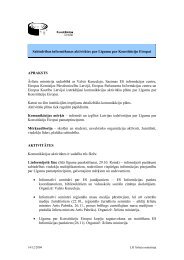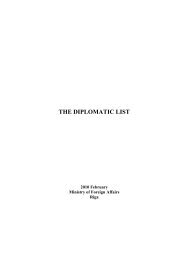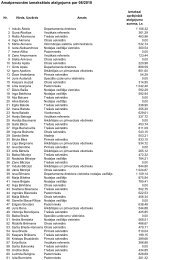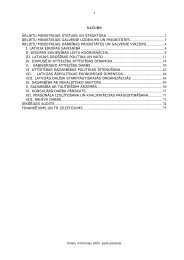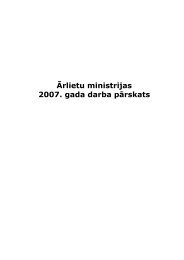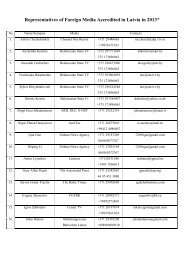Nr.2(10) / 2013.gada jūnijs - Par es.gov.lv
Nr.2(10) / 2013.gada jūnijs - Par es.gov.lv
Nr.2(10) / 2013.gada jūnijs - Par es.gov.lv
You also want an ePaper? Increase the reach of your titles
YUMPU automatically turns print PDFs into web optimized ePapers that Google loves.
56Alexander Sergunin•• Russia shar<strong>es</strong> the BSR countri<strong>es</strong>’ environmental concerns. The BalticSea is one of the most polluted seas in the world and Russia, beingthe major pollutant in the BSR, fully realiz<strong>es</strong> the need for jointcooperative efforts to so<strong>lv</strong>e the regional ecological problems.Based on this analysis of Russia’s national inter<strong>es</strong>ts in the BSR, the articlewill try to examine how Moscow interacts with another major player in theBaltic Sea area, the European Union, and whether their regional strategi<strong>es</strong>are compatible and mutually reinforcing, or ignore or even confront eachother.Russia and the EU Strategy for the Baltic Sea Region:venu<strong>es</strong> for cooperation and areas of contentionIt is widely acknowledged both by European and Russian experts thatthe EU Strategy for the Baltic Sea Region (EUSBSR) of 2009 was mainlyd<strong>es</strong>igned as an EU-internal strategy and largely ignored the non-EU regionalactors, such as Russia, Iceland and Norway. 1 At the same time, three out ofthe four pillars of the Strategy — environmental protection, attractiven<strong>es</strong>sand acc<strong>es</strong>sibility, and safety and security — depend heavily on external actors,including Russia. Naturally, if Brussels wanted to succ<strong>es</strong>sfully implement theStrategy, it had to be engaged in intensive cooperation with Russia.It should be noted that Russia lacks a special strategy for the BSR.Moscow did not react formally to the EUSBSR. 2 There was a feeling inRussia that the country has not been included in the BSR integrationproc<strong>es</strong>s as much as it could. Russian strategy makers prefer to deal withBaltic issu<strong>es</strong> either on a bilateral (country-to-country) or multilateral (theNorthern Dimension partnerships, Council of the Baltic Sea Stat<strong>es</strong> (CBSS),1The EU Strategy for the Baltic Sea Region. The second year of implementation. Positionpaper of the BSSSC. 18 May 2011, p. 3. http://www.bsssc.com/upload/dokumenty/f_176.pdf (Homepage of BSSC; visited <strong>10</strong>.05.2013.).; Sergunin A. Russia. Political State of the Region Report. Eds.B. Henningsen and T. Etzold. Copenhagen: The Baltic Development Forum, 2011, pp. 45–50. http://www.bdforum.org/cmsystem/wp-content/uploads/BDF_Political_SoRR_2011.pdf (Home page ofBaltic Development Forum; visited <strong>10</strong>.05.2013.).2Elo K., Kaakkuriniemi T. Russia’s Baltic Sea Polici<strong>es</strong> and the EU’s Strategy for the Baltic SeaRegion: Squaring the Circle? In: Political State of the Region Report 2012. Eds. B. Henningsen andT. Etzold. Copenhagen: The Baltic Development Forum, 2012, pp. 14–24; Oldberg I. Soft security inBaltic Sea Region. Russian inter<strong>es</strong>ts in the Council of the Baltic Sea Stat<strong>es</strong>. Occasional UP Papers.Stockholm: The Swedish Institute of International Affairs. No. 12, 2012.



